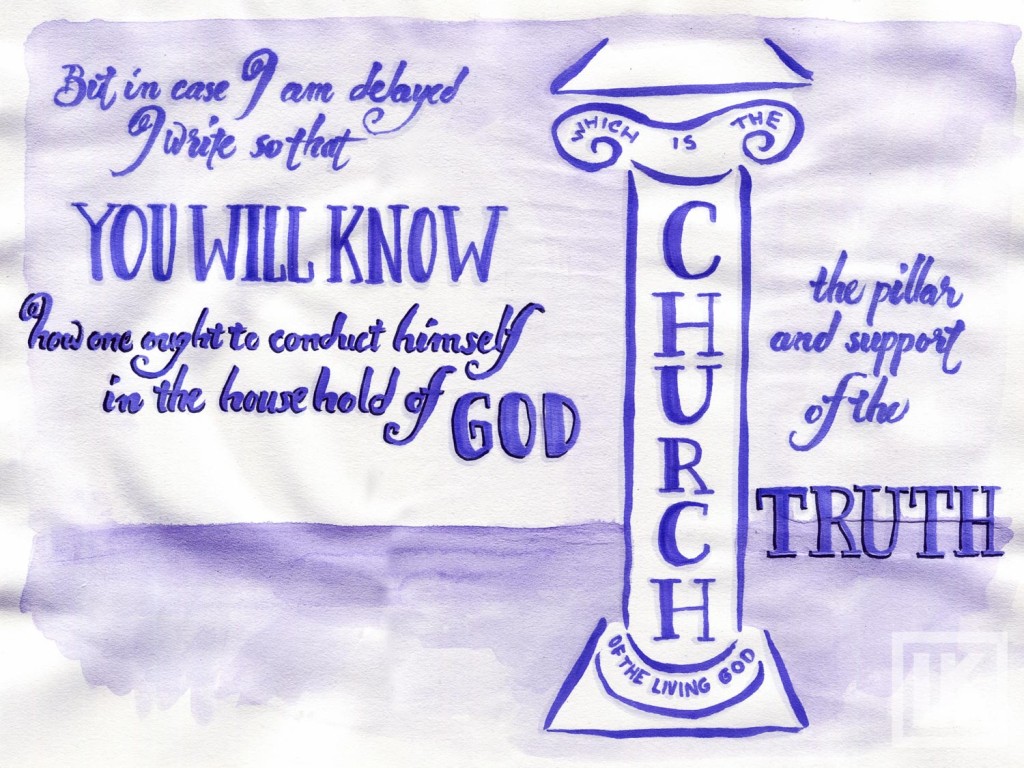![]() Timothy was Paul‘s protege, his “child in the faith” (1 Ti 1:2). Paul had left Timothy in the city of Ephesus to steer certain men away from false doctrine and provide sound leadership. This is Paul’s follow-up letter.
Timothy was Paul‘s protege, his “child in the faith” (1 Ti 1:2). Paul had left Timothy in the city of Ephesus to steer certain men away from false doctrine and provide sound leadership. This is Paul’s follow-up letter.
1 Timothy is about sound doctrine and godliness. Paul deals with two main issues in this epistle:
- What Christians should or should not teach. False teachers had already cropped up in the early church, and Timothy was sure to deal with more of them. Paul encourages Timothy to maintain sound teaching regarding the law and the gospel (1 Ti 1:8–17), gifts from God (1 Ti 4:1–5), and the Scriptures (1 Ti 4:13). Timothy is also charged with teaching his church to behave in a godly way, which means he spends even more time discussing . . .
- What godliness looks like in the church. From family to finances, from prayer to church leadership—Paul walks through several facets of life and discusses how to go about them in godly ways. The Greek word most commonly translated “godliness” or “piety” in the New Testament appears eight times in First Timothy: it doesn’t show up this much in any other book of the Bible.
First Timothy is a letter to a young church leader with specific instructions on how to “fight the good fight” (1 Ti 1:.18; 6:12). This book gives us a look at Paul’s instructions regarding the challenges Timothy faced—challenges many pastors still face today.
Theme verse of 1 Timothy
“But in case I am delayed, I write so that you will know how one ought to conduct himself in the household of God, which is the church of the living God, the pillar and support of the truth.” (1 Ti 3:15)
1 Timothy’s role in the Bible
 First Timothy is the first of Paul’s pastoral epistles—letters written to church leaders he knew. In contrast, most of Paul’s epistles were written to entire congregations. Titus also received a pastoral epistle from Paul, but Timothy got two.
First Timothy is the first of Paul’s pastoral epistles—letters written to church leaders he knew. In contrast, most of Paul’s epistles were written to entire congregations. Titus also received a pastoral epistle from Paul, but Timothy got two.
Timothy has a special relationship with Paul, and it shows. In this letter (and Second Timothy), we see Paul’s expectations of Timothy. This young church leader is specifically responsible for maintaining Paul’s standard of teaching in the church of Ephesus.
Paul probably wrote First Timothy a few years after he wrote Ephesians, the book that was read to the congregation Timothy now lead.
But First Timothy’s tone is notably different from Ephesians’. For example, whereas Paul’s instructions in Ephesians deal more with the high-level “Why?” and What?”, his charges to Timothy are in great detail and focus more on the “How.”
So while Ephesians lists general ways a Christian can walk in a manner worthy of the Lord, First Timothy lays out specific ways to honor elders and widows,
Why the stark difference in Paul’s approach? The text gives us a few reasons:
- Paul was writing to a fellow church leader. His letters to churches had to be general: if they were too specific, they wouldn’t be applicable to the common listener. However, First Timothy was written from one preacher to another preacher, from one church leader to another church leader, from one Jewish Christian to another Jewish Christian.
- Paul was writing to a friend. Paul and Timothy had many shared experiences, and he was very familiar with the challenges Timothy faced, whether in ministry or in health (1 Ti 5:23).
This book gives us a good look at the challenges pastors face, but more importantly, how Paul instructs Timothy to deal with them.
Quick outline of 1 Timothy
- Sound teaching: the law and mercy (1 Ti 1)
- Living in godliness and dignity (1 Ti 2–3)
- Prayer (1 Ti 2:1–8)
- Marriage (1 Ti 2:9–15)
- Overseers (1 Ti 3:1–7)
- Deacons (1 Ti 3:8–13)
- Paul’s reason to write (1 Ti 3:14–16)
- Sound teaching: discipline and godliness (1 Ti 4)
- Overseeing the church (1 Ti 5:1–6:10)
- Caring for widows (1 Ti 5:1–16)
- Honoring elders (1 Ti 5:17–25)
- Identifying false teachers (1 Ti 6:1–10)
- Charge to godliness (1 Ti 6:11–21)
Pages related to 1 Timothy
- Pauline epistles
- 2 Timothy (next book of the Bible)
- 2 Thessalonians (previous)
- Titus (third pastoral epistle)
- Philemon (also written to a church leader)



